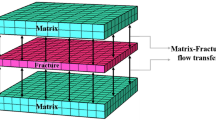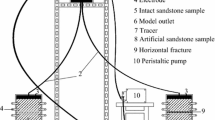Abstract
Assessing preferential flow that occurs through small fractures or permeable connected pathways of other kinds is important to many processes but is difficult to determine, since most chemical tracers diffuse quickly enough from small flow channels that they appear to move more uniformly through the rock than they actually do. Conventional tracer and micro tracer experiments were conducted using two different synthetically single-fractured limestone core plugs to investigate non-isothermal-coupled heat and mass transfer in a single fracture-matrix system. Conventional Rhodamine B and suspension of micro particles based on melamine resin, Rhodamine B-marked size 1-µm tracer with constant concentration were injected at constant flow rate during non-isothermal flow-through experiments. Effluent tracer concentrations were measured using the fluorescence spectrometry technique. A numerical simulation model was used to determine effective thermal and physical properties involved in matrix-fracture transfers during conventional tracer injection. Numerical studies indicated that matrix permeability is the main controlling factor for tracer dispersion within the matrix. The results showed that tracer transfer from the fracture to the matrix at low injection rates is higher compared to that of higher injection rates. As the fracture provides a large transport pathway for micro particles compared to the surrounding matrix, advection causes the early breakthrough for micro particle transport through a single fracture-matrix system. When the conventional tracer has a long enough transit through the system to diffuse into the matrix, but the micro tracer does not, the micro tracer arrives first and the conventional tracer later, and the separation measures the degree of preferential flow.

















Similar content being viewed by others
Abbreviations
- r:
-
radius (cm)
- b:
-
half aperture of fracture (cm)
- To :
-
outer temperature of core plug (°C).
- Tf :
-
fluid temperature in fracture (°C)
- Ti :
-
initial temperature of core plug (°C)
- Tin :
-
inlet temperature of fluid (°C)
- Df :
-
dispersion coefficient in fracture (cm2/min)
- α L :
-
longitudinal dispersivity in fracture (cm)
- u:
-
fluid velocity (cm/min).
- Dm :
-
molecular diffusion coefficient (cm2/min).
- De :
-
effective diffusion coefficient (cm2/min).
- τ:
-
tortuosity of matrix.
- Cf :
-
solute concentration in fracture (ppb).
- t:
-
time (min)
- Df :
-
dispersion coefficient in fracture (cm2/min).
- Ø:
-
porosity (%)
- Cm :
-
solute concentration in matrix (ppb)
- Dx :
-
dispersion coefficient in x direction (cm2/min)
- Dy :
-
dispersion coefficient in y direction (cm2/min)
- Dz :
-
dispersion coefficient in z direction (cm2/min)
- Cin :
-
inlet concentration (ppb).
- Cout :
-
outlet concentration (ppb).
- Δt:
-
time interval (min).
- V:
-
injection volume (lit).
- m• :
-
mass flow rate (μg/min).
- m:
-
mass of solute (μg).
References
Bergman TL, Incropera FP, DeWitt DP, Lavine AS (1992) Fundamentals of heat and mass transfer, 7th edn. John Wiley & Sons, New York, US
Berre I, Doster F, Keilegavlen E (2019) Flow in fractured porous media: a review of conceptual models and discretization approaches. Transport Porous Med 130(1):215–236
Bijeljic B, Rubin S, Scher H, Berkowitz B (2011) Non-Fickian transport porous media with bimodal structural heterogeneity. J Contam Hydrol 120:213–221
Bird RB, Stewart WE, Lightfoot EN (2002) Transport phenomena, 2nd edn. John Wiley & Sons, New York, US
Bodin J, Delay F, De Marsily G (2003) Solute transport in a single fracture with negligible matrix permeability: 1. fundamental mechanisms. Hydrogeol. J. 11(4), 418–433
Boon M, Bijeljic B, Krevor S (2017) Observations of the impact of rock heterogeneity on solute spreading and mixing. Water Resour Res 53(6):4624–4642
Boving TB, Grathwohl P (2001) Tracer diffusion coefficients in sedimentary rocks: correlation to porosity and hydraulic conductivity. J Contam Hydrol 53(1–2):85–100
Charette VJ, Evangelista E, Chertcoff R, Auradou H, Hulin J-P, Ippolito I (2007) Influence of the disorder on solute dispersion in a flow channel. Eur Phys J Appl Phys 39(3):267–274
CMG STARS Manual (2020) Advanced process and thermal reservoir simulator, CMG STARS, Computer Modelling Group Ltd., Calgary, AB, Calgary, Canada
Dietrich P, Helmig R, Hötzl H, Sauter M, Köngeter J, Teutsch G (2005) Flow and transport in fractured porous media. Springer Science & Business Media, Berlin, Heidelberg
Geiger S, Cortis A, Birkholzer J (2010) Upscaling solute transport in naturally fractured porous media with the continuous time random walk method. Water Resour Res 46(12):W12530
Grisak G, Pickens J (1981) An analytical solution for solute transport through fractured media with matrix diffusion. J Hydrol 52(1–2):47–57
Grisak G, Pickens J, Cherry J (1980) Solute transport through fractured media: 2. Column study of fractured till. Water Resour. Res. 16(4), 731–739
Grisak GE, Pickens J-F (1980) Solute transport through fractured media: 1. The effect of matrix diffusion. Water Resour. Res. 16(4), 719–730
Khuzhayorov B, Mustofokulov Z (2019) The adsorbed solute transport with diffusion effects. J Appl Comput Math 8(1):1–4
Khuzhayorov B, Mustofoqulov J, Ibragimov G, Md Ali F, Fayziev B (2020) Solute transport in the element of fractured porous medium with an inhomogeneous porous block. Symmetry 12(6):1028
Khuzhayorov B, Mustofoqulov Z (2018) Transport of active solute in a fractured porous medium with nonequilibrium adsorption. Int J Adv Res Sci Eng Technol 5(12):7589–7597
Kumar G (2012) A review on fluid dynamics of fractured reservoir geology. Int J Geol 6(2):45–52
Olasolo P, Juárez M, Morales M, Liarte I (2016) Enhanced geothermal systems (EGS): a review. Renew Sustain Energy Rev 56:133–144
Ramírez-Sabag J, Valdiviezo-Mijangos O, Coronado M (2005) Inter-well tracer tests in oil reservoirs using different optimization methods: a field case. Geofis Int 44(1):113–120
Reddy DS, Govardhan K (2015) Effect of viscous dissipation, soret and dufour effect on free convection heat and mass transfer from vertical surface in a porous medium. Procedia Mater Sci 10:563–571
Reddy PS, Rao KS, Rao DP, Mamatha E (2010) Thermo-diffusion and diffusion–thermo effects on convective heat and mass transfer through a porous medium in a circular cylindrical annulus with quadratic density temperature variation–a finite element study. Int J Dyn Fluid 6(1):97–106
Reddy PS, Rao V (2012) Thermo-diffusion and diffusion–thermo effects on convective heat and mass transfer through a porous medium in a circular cylindrical annulus with quadratic density temperature variation–finite element study. J Appl Fluid Mech 5(4):139–144
Sahimi M (2011) Flow and transport in porous media and fractured rock: from classical methods to modern approaches, 2nd edn. John Wiley & Sons
Schmelling S, Ross R (1989) Superfund ground-water issue. Contaminant transport in fractured media: Models for decision makers, Environmental Protection Agency, Washington, DC USA. Report EPA/540/4–89/004
Tavakkoli Osgouei Y, Akin S (2021) Experimental and numerical study of flow and thermal transport in fractured rock. Heat Mass Transf 57:1053–1068. https://doi.org/10.1007/s00231-020-03001-w
Tsang Y, Tsang C, Neretnieks I, Moreno L (1988) Flow and tracer transport in fractured media: a variable aperture channel model and its properties. Water Resour Res 24(12):2049–2060
Tunnish A, Shirif E, Henni A (2019) History matching of experimental and CMG-STARS results. J Petrol Explor Prod Technol 9(1):341–351
Werth CJ, Cirpka OA, Grathwohl P (2006) Enhanced mixing and reaction through flow focusing in heterogeneous porous media. Water Resour Res 42(12):W12414
Zhu Y, Zhan H (2018) Quantification of solute penetration in an asymmetric fracture-matrix system. J Hydrol 563:586–598
Zhu Y, Zhan H, ** M (2016) Analytical solutions of solute transport in a fracture–matrix system with different reaction rates for fracture and matrix. J Hydrol 539:447–456
Zou L, **g L, Cvetkovic V (2016) Assumptions of the analytical solution for solute transport in a fracture-matrix system. Int J Rock Mech Min Sci 83:211–217
Author information
Authors and Affiliations
Corresponding author
Ethics declarations
Conflict of interest
The authors declare no competing interests.
Additional information
Responsible Editor: Santanu Banerjee
Rights and permissions
Springer Nature or its licensor (e.g. a society or other partner) holds exclusive rights to this article under a publishing agreement with the author(s) or other rightsholder(s); author self-archiving of the accepted manuscript version of this article is solely governed by the terms of such publishing agreement and applicable law.
About this article
Cite this article
Osgouei, Y.T., Akin, S. Flow and tracer transport in a single fracture at non-isothermal conditions. Arab J Geosci 15, 1723 (2022). https://doi.org/10.1007/s12517-022-11017-1
Received:
Accepted:
Published:
DOI: https://doi.org/10.1007/s12517-022-11017-1




